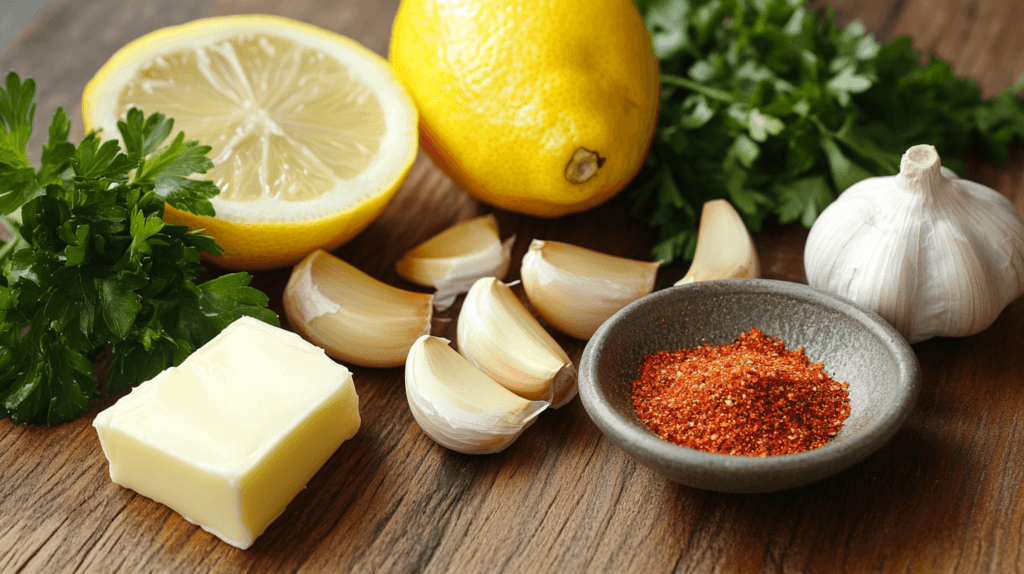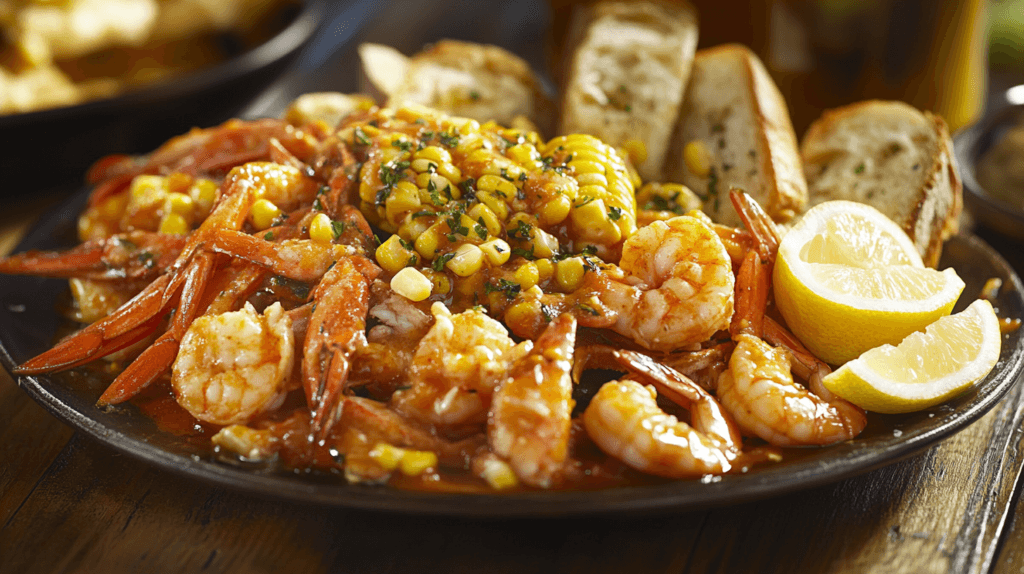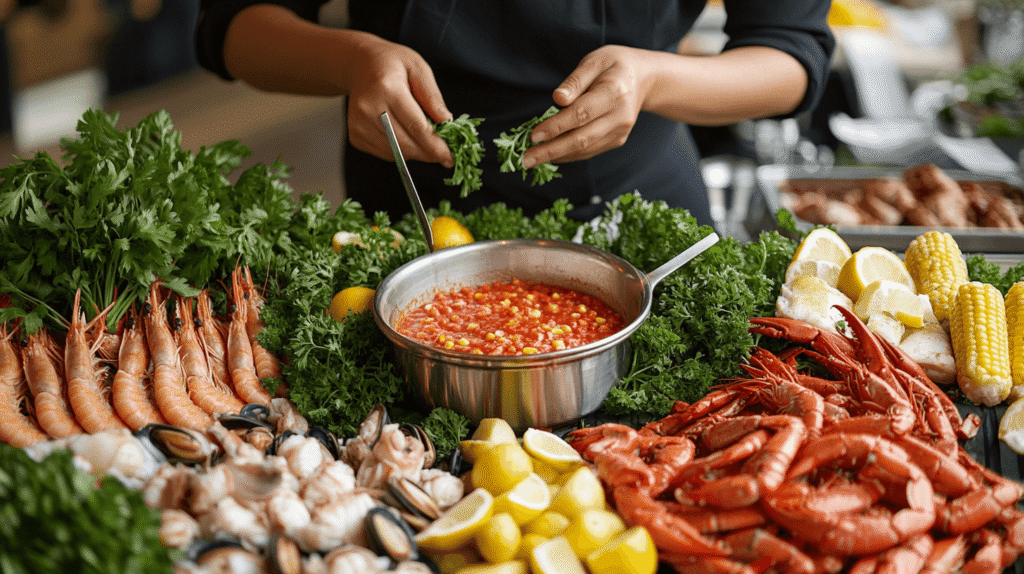Few dishes bring people together like a seafood boil. Whether it’s a summer gathering or a special occasion, the heart of this communal feast lies in its vibrant and flavorful seafood boil sauce. This sauce is the unsung hero, tying together the succulent flavors of shrimp, crab, lobster, and other seafood with a perfect blend of spices, butter, and aromatics. If you’ve ever wondered how to create a sauce that will have everyone dipping, dunking, and savoring every last bite, you’re in the right place.
In this guide, you’ll discover everything you need to know about making the perfect seafood boil sauce, from selecting the right ingredients to mastering the preparation process. Let’s dive in and make your next seafood boil unforgettable!
Table of Contents
What is a Seafood Boil Sauce?
A Brief Overview of Seafood Boil Tradition
A seafood boil is a festive meal that originated in coastal regions, particularly in the Southern United States. This communal dining experience often features a mix of seafood, corn, potatoes, and sausage boiled together in a seasoned broth. While the cooking method is key, it’s the accompanying sauce that takes the dish to the next level.
Why the Sauce Makes the Meal Perfect
The seafood boil sauce isn’t just a condiment; it’s a flavor enhancer that ties the entire meal together. Its buttery, garlicky, and spicy notes complement the natural sweetness of seafood while adding depth and richness. Whether poured over the boil or used as a dipping sauce, it’s the element that transforms a good seafood boil into a great one.
Ingredients for the Perfect Seafood Boil Sauce

Essential Ingredients for Your Seafood Boil Sauce Recipe
To make the ultimate seafood boil sauce, you’ll need the following basics:
- Butter (unsalted): The creamy base for the sauce.
- Garlic (minced): The aromatic cornerstone.
- Old Bay seasoning: A classic seafood spice blend.
- Paprika: Adds smokiness and depth.
- Cayenne pepper: For that signature kick of heat.
- Lemon juice: Brightens the sauce and cuts through the richness.
- Chicken or seafood stock: Enhances the sauce’s savory flavor.
Optional Add-ins for Custom Flavors
- Brown sugar: For a hint of sweetness.
- Chili flakes: For extra heat.
- Fresh parsley: A herby touch to finish.
- Worcestershire sauce: Adds a complex umami flavor.
- White wine: For a sophisticated edge.
Tips for Selecting Fresh Ingredients
- Opt for freshly minced garlic instead of pre-minced jars for the best flavor.
- Use fresh lemon juice rather than bottled to avoid an overly acidic taste.
- When possible, choose high-quality butter for a richer, creamier base.
Equipment Needed for Seafood Sauce Recipe
Must-Have Kitchen Tools for a Seafood Boil Sauce Recipe
Creating a delectable seafood boil sauce requires a few simple tools that you probably already have in your kitchen:
- Medium saucepan: Ideal for melting butter and simmering the ingredients together.
- Wooden spoon or silicone spatula: For stirring the sauce and preventing it from sticking to the pan.
- Garlic press (optional): For quickly mincing garlic to release its full flavor.
- Measuring cups and spoons: To ensure accurate ingredient proportions.
Substitutes You Can Use in a Pinch
- If you don’t have a garlic press, use the flat side of a knife to crush garlic cloves before mincing them.
- No saucepan? A small skillet will work just as well for this recipe.
- In the absence of measuring tools, use approximate ratios: one stick of butter is about ½ cup, and a pinch equals roughly 1/8 teaspoon.
Step-by-Step Guide to Making the Sauce
Preparing Your Ingredients for the Seafood Boil Sauce Recipe
Before you begin, gather all your ingredients and prep them:
- Mince the garlic finely to ensure it blends well into the sauce.
- Measure out your spices—Old Bay seasoning, paprika, cayenne, and any optional additions—so you can add them quickly.
- Juice the lemon and set it aside for later.
Cooking the Base
- Place your saucepan over medium heat.
- Add the butter and allow it to melt completely. Be careful not to overheat, as butter can burn quickly. Lower the heat if needed.
- Stir in the minced garlic and cook for 1-2 minutes, just until fragrant. Avoid browning the garlic, as it can turn bitter.
Adding Flavorful Spices for the Seafood Boil Sauce Recipe
- Gradually sprinkle in the Old Bay seasoning, paprika, and cayenne pepper. Stir well to combine.
- Pour in the chicken or seafood stock, mixing continuously to create a smooth base.
- Add a squeeze of fresh lemon juice for brightness and balance.
Balancing Heat and Sweetness
- Taste the sauce and adjust to your preference. If it’s too spicy, add a pinch of brown sugar or more butter to mellow the heat.
- If you’d like more spice, toss in additional cayenne pepper or chili flakes.
Simmer the sauce gently for 5-7 minutes to allow the flavors to meld together. Once done, remove it from heat and let it cool slightly before serving.
The Secret to Balancing Flavors in a Seafood Boil Sauce
Creating the perfect seafood boil sauce is an art of balancing different flavor profiles: richness, acidity, spiciness, and sweetness. Here’s how to achieve the perfect harmony:
Richness and Creaminess
Butter is the key to a luxurious, creamy base. For added depth, consider mixing unsalted butter with a splash of cream or a touch of olive oil. These fats help coat the seafood and lock in moisture while delivering a melt-in-your-mouth experience.
Acidity for Brightness
Acidity from lemon juice or vinegar cuts through the richness of the butter and enhances the natural sweetness of the seafood. Be sure to taste and adjust as you add lemon juice to avoid overpowering the sauce.
Balancing Heat
The spice level is what makes seafood boil sauce exciting. Use cayenne pepper, paprika, and chili flakes to customize the heat. For those who prefer mild flavors, dial back on the cayenne and add extra garlic or parsley for aroma and flavor.
Sweetness for Contrast
A touch of sweetness balances the savory and spicy elements. Brown sugar is a popular choice, but honey or even a dash of molasses can work beautifully, depending on your taste.
By thoughtfully combining these elements, your seafood boil sauce will deliver a complex, layered flavor profile that leaves everyone asking for seconds.
Customizing Your Seafood Boil Sauce Recipe
Adjusting Spice Levels
Not everyone enjoys the same level of heat. You can easily tweak the spice profile of your sauce:
- For mild heat, reduce or omit the cayenne pepper and chili flakes.
- For medium heat, stick to the recipe proportions.
- For extra heat, add fresh chopped chili or a few dashes of hot sauce.
Adding Lemon and Garlic Variations
Want a tangier or garlicky punch?
- Add zest from the lemon before juicing it.
- Double the garlic amount if you’re a fan of bold flavors.
Regional Twists on the Recipe
- Cajun Style: Add Cajun seasoning, smoked sausage drippings, and a splash of hot sauce.
- Asian Fusion: Mix in soy sauce, ginger, and a drizzle of sesame oil for an umami-rich version.
Pairing Your Sauce with Seafood

The Best Seafood Choices for Your Sauce
A good seafood boil sauce is versatile and pairs beautifully with a wide variety of seafood. Here are some popular choices:
- Shrimp: The sweetness of shrimp pairs wonderfully with the buttery, garlicky sauce.
- Crab legs: Whether it’s snow crab or king crab, the sauce enhances the natural brininess.
- Lobster tails: The rich, succulent meat of lobster is elevated with this sauce.
- Clams and mussels: Their mild flavor is the perfect canvas for the bold seasoning.
- Crawfish: A Southern classic that soaks up every bit of the sauce’s goodness.
For variety, you can even mix multiple types of seafood in one boil, allowing the sauce to tie everything together.
How to Complement Sides and Vegetables
A seafood boil isn’t complete without sides and veggies that soak up the sauce’s flavors:
- Corn on the cob: Dip the corn directly into the sauce for a buttery, spicy treat.
- Baby potatoes: Toss them in the sauce for a rich, savory coating.
- Sausages: Smoked or spicy sausages absorb the sauce beautifully.
- French bread: Use it to mop up every last drop of sauce from your plate.
For added flair, drizzle the sauce over rice or pasta as a base for your seafood boil.
Storage and Reheating Tips for Your Sauce
Proper storage and reheating are essential to preserve the quality, flavor, and texture of your seafood boil sauce. Whether you have leftovers or want to prepare it ahead of time, follow these detailed tips:
Proper Storage Methods for Seafood Boil Sauce Recipe
- Cool Before Storing:
Let the sauce cool completely at room temperature before transferring it to storage containers. Storing it while hot can cause condensation, which may dilute the sauce or encourage bacterial growth. - Choose the Right Containers:
- Use airtight containers to keep the sauce fresh and prevent it from absorbing other odors in the refrigerator or freezer.
- For freezing, consider dividing the sauce into smaller portions using freezer-safe bags or silicone molds for easier defrosting later.
- Label and Date:
Write the storage date on the container to ensure you consume it within the recommended time frame:- Refrigeration: Up to 5 days.
- Freezing: Up to 3 months.
- Seal Properly:
Make sure the lid is tightly secured to prevent air exposure, which can cause the sauce to lose its flavor over time.
Reheating Without Losing Flavor in Your Sauce Recipe
Reheating seafood boil sauce properly ensures it retains its rich, buttery texture and bold flavors. Follow these methods for the best results:
- Stovetop Method (Recommended):
- Transfer the sauce to a small saucepan.
- Heat it over low to medium heat, stirring frequently to prevent it from sticking or separating.
- If the sauce has thickened during storage, add a splash of chicken or seafood stock, water, or melted butter to bring it back to the desired consistency.
- Microwave Method (Quick Option):
- Place the sauce in a microwave-safe bowl.
- Cover it with a microwave-safe lid or wrap to prevent splattering.
- Reheat in 15-20 second intervals, stirring between each interval to ensure even heating. Avoid overheating, which can cause the butter to separate.
- Double Boiler Method (For Precise Results):
- Fill a larger pot with water and bring it to a simmer.
- Place the sauce in a heatproof bowl or smaller pot and set it over the simmering water.
- Stir continuously until the sauce is warmed through. This method prevents direct heat, ensuring the sauce stays creamy without breaking.
Tips to Maintain Flavor and Texture
- Avoid Freezer Burn:
When freezing, press the air out of the storage bag or container before sealing. This minimizes exposure to air and prevents freezer burn. - Freshen Up the Sauce:
After reheating, add a squeeze of fresh lemon juice, a pat of butter, or a pinch of seasoning to refresh the flavors. - Do Not Refreeze:
Once the sauce has been defrosted, avoid refreezing it, as this can degrade its quality and alter the texture.
By following these detailed storage and reheating tips, your seafood boil sauce will taste just as delicious as when it was first made, ensuring every meal is a flavorful success!crowave for reheating, as it can cause uneven heating and affect the flavor.
Frequently Asked Questions
Can I Freeze Seafood Boil Sauce?
Yes, seafood boil sauce freezes well! Store it in an airtight container, leaving some space for expansion. When you’re ready to use it, thaw it in the fridge overnight and reheat it over low heat.
What If I Don’t Have Old Bay Seasoning?
If you don’t have Old Bay seasoning, you can make a substitute using a mix of paprika, celery salt, mustard powder, black pepper, and cayenne pepper.
How Do I Adjust the Recipe for a Smaller Serving?
To make a smaller batch, simply halve or quarter the ingredient amounts. The cooking process remains the same.
Is This Sauce Suitable for Vegetarians?
Yes, you can make a vegetarian version by using vegetable stock instead of chicken or seafood stock. Omit any optional ingredients like Worcestershire sauce, which often contains anchovies.
How Long Can the Sauce Be Stored?
When properly stored in the refrigerator, the sauce will last up to 5 days. For extended storage, freeze it for up to 3 months.
Conclusion
Creating the perfect seafood boil sauce is all about balancing flavors and tailoring it to your preferences. This buttery, garlicky, and slightly spicy sauce elevates any seafood boil into a feast worth remembering. With simple ingredients, customizable spice levels, and easy storage options, this recipe is perfect for gatherings or casual meals alike.
For inspiration, you could pair this sauce with decadent seafood dishes like Crab Brûlée Recipe, or explore flavorful creations like Balsamic Chicken Recipe. You might even draw parallels with the tangy flavors found in Filipino Sinigang, showcasing its versatility across different cuisines.
Whether you’re dipping shrimp, drizzling over crab legs, or tossing it with potatoes and corn, this sauce ties every element of a seafood boil together. Now that you have the recipe and tips, it’s time to gather your ingredients, don your apron, and bring this irresistible sauce to life. Trust us, it’ll be the star of your next seafood boil!

